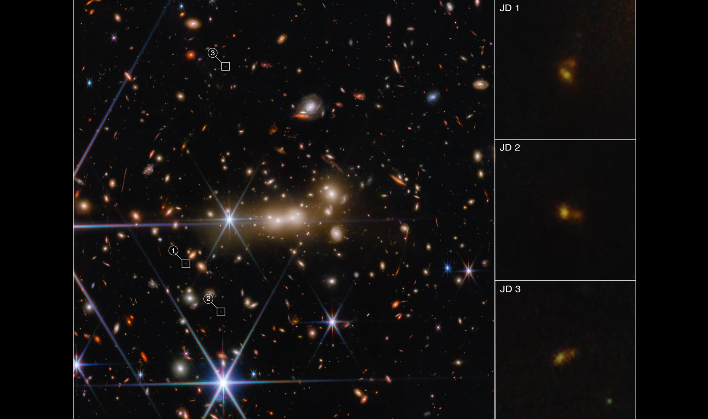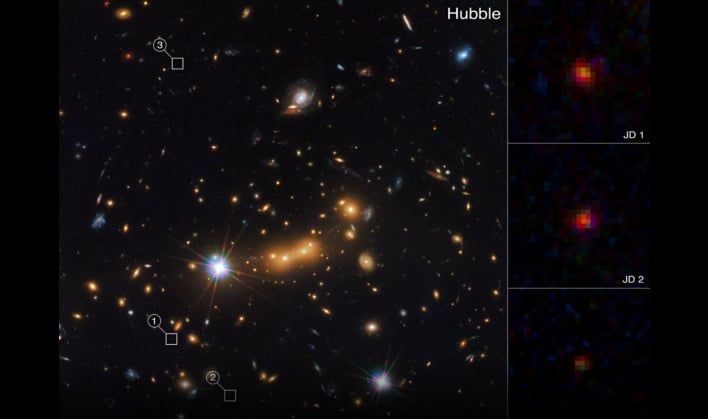NASA's Webb Telescope Looks Back In Time To Capture A Galaxy 5.6 Billion Light-Years Away
NASA's James Webb Space Telescope (JWST) reached far back into the universe's past, and captured a galaxy whose light took 13.3 billion years to reach Earth. When MACS0647-JD was first discovered in 2012, it set a new distance record for finding the farthest galaxy seen in the universe at that time.
Astronomers have been having a field day since Webb was made fully operational by NASA, due to all the amazing images and data it has been sending back to Earth. The telescope was designed to be able to detect faint infrared light from extremely distant galaxies, in order to give more insight into the early universe. Now, one of the most recent photos taken by JWST takes astronomers 5.6 billion light-years from Earth, to a galaxy far, far away.
MACS0647-JD was first spotted 10 years ago with the aid of the Hubble telescope, but at that time it only appeared as a pale, red dot, according to Dan Coe, who helped discover the galaxy. He remarked, "We could tell it was really small, just a tiny galaxy in the first 400 million years of the universe. Now we look with Webb, and we're able to resolve TWO objects!" Coe is helping to determine if those two objects are galaxies, or two clumps of stars within a galaxy.
Tiger Hsiao, from Johns Hopkins University, pointed out that the colors between the two objects differ in color. He notes that one is bluer, while the other is redder. Hsiao stated, "The blue one actually has very young star formation and almost no dust, but the small, red object has more dust inside, and is older." He goes to suggest that what could be happening is a galaxy merger in the early universe.
Coe adds that because of the gravitational lensing of the mammoth galaxy cluster, it appears three times in the image (shown in the top image as JD1, JD2, and JD3).
Rebecca Larson, a National Science Foundation fellow and a PhD graduate student at the University of Texas at Austin, described her favorite part of looking at Webb images as being when "you look in the background, there are all these little dots - and those dots are galaxies!" She added that the Webb team has not yet attempted focusing on one spot for a long period of time, therefore images like this are just the beginning.
Astronomers have been having a field day since Webb was made fully operational by NASA, due to all the amazing images and data it has been sending back to Earth. The telescope was designed to be able to detect faint infrared light from extremely distant galaxies, in order to give more insight into the early universe. Now, one of the most recent photos taken by JWST takes astronomers 5.6 billion light-years from Earth, to a galaxy far, far away.
MACS0647-JD was first spotted 10 years ago with the aid of the Hubble telescope, but at that time it only appeared as a pale, red dot, according to Dan Coe, who helped discover the galaxy. He remarked, "We could tell it was really small, just a tiny galaxy in the first 400 million years of the universe. Now we look with Webb, and we're able to resolve TWO objects!" Coe is helping to determine if those two objects are galaxies, or two clumps of stars within a galaxy.
Tiger Hsiao, from Johns Hopkins University, pointed out that the colors between the two objects differ in color. He notes that one is bluer, while the other is redder. Hsiao stated, "The blue one actually has very young star formation and almost no dust, but the small, red object has more dust inside, and is older." He goes to suggest that what could be happening is a galaxy merger in the early universe.
Coe adds that because of the gravitational lensing of the mammoth galaxy cluster, it appears three times in the image (shown in the top image as JD1, JD2, and JD3).
Rebecca Larson, a National Science Foundation fellow and a PhD graduate student at the University of Texas at Austin, described her favorite part of looking at Webb images as being when "you look in the background, there are all these little dots - and those dots are galaxies!" She added that the Webb team has not yet attempted focusing on one spot for a long period of time, therefore images like this are just the beginning.



